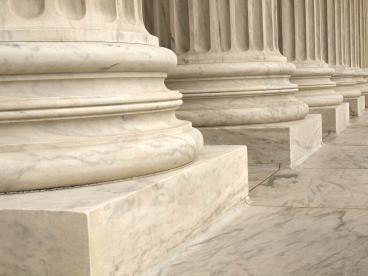On June 29, 2023, in Students for Fair Admissions, Inc. v. President and Fellows of Harvard College and Students for Fair Admissions, Inc. v. University of North Carolina, the US Supreme Court made it unlawful for universities and colleges to consider a college applicant’s race in college admissions decisions designed to achieve the objective of a more diverse student body. Although the decision does not address corporate diversity, equity, and inclusion (DEI) efforts in the workplace, the upshot of the Court’s ruling could have implications for such efforts, including federal contractor affirmative action programs.
Background — the Federal Contractor Affirmative Action Model
Federal contractors and subcontractors have been subject to the affirmative action requirements of Executive Order (EO) 11246 since 1965. Although we can expect challenges based on the Supreme Court’s college admissions decision, the Court’s ruling should have little to no impact on EO 11246 and federal contractors’ affirmative action obligations. Whereas affirmative action in college admissions in some cases has involved granting preferences to otherwise qualified applicants based on race and gender to achieve a diverse student body, EO 11246 and its implementing regulations, as well as Title VII of the Civil Rights Act of 1964, which covers all employers, expressly prohibit granting race- and gender-based preferences in making employment decisions. Rather, to achieve the goal of a more diverse workforce, the federal contractor affirmative action regulations rely on the obligations of contractors to engage in affirmative outreach and recruiting efforts designed to attract a diverse pool of qualified applicants on the theory that the more diverse the pool of qualified candidates, the more likely the result will be a diverse workforce. EO 11246 is all about leveling the playing field to give historically underrepresented groups a fair and equal chance to compete, but it still requires employers to hire and promote the most qualified individuals on a race- and gender-neutral basis.
Therefore, as long as federal contractors adhere to the core requirements of the EO by casting a wide net in their recruitment efforts to create diverse applicant pools, while ensuring their applicant selection processes are race and gender neutral, there should be no cause for alarm or change. For this reason, federal contractor affirmative action programs can serve as a useful framework for considering corporate DEI programs in the context of the Court’s decision.
Impact on Corporate DEI Initiatives
Workplace DEI programs include efforts to promote equal opportunities for job applicants and employees, which may involve diversity training and recruitment initiatives, racial equity audits, and commitments to equal pay. Corporate DEI efforts — including expectations about the diversity of publicly held company boards and related disclosures as well as broader expectations about workforce diversity disclosures — have been a focal point for companies and their investors over the past several years. For public companies, this is reflected by Nasdaq’s board diversity listing rules, by Institutional Shareholder Services’ and Glass Lewis’ proxy voting policies, by the proxy voting policies of large institutional investors, and in shareholder proposals.
Shareholder proposals include those that focus on the disclosures made by companies about their board diversity strategies and that seek adoption of board diversity policies, such as policies following the “Rooney Rule,”[1] or the publication of reports on the companies’ diversity policies and practices. Particularly among large public companies, it has become more common to disclose having a Rooney Rule or similar policy that seeks to include individuals from historically underrepresented groups in the candidate pool when recruiting new directors. Both privately and publicly held companies have adopted similar policies for hiring employees more broadly. Some shareholders have also pushed public companies to disclose their EEO-1 reports or similar workforce diversity metrics and to separately publish reports on the effectiveness of companies’ DEI efforts.
Practical Implications for Corporate DEI Programs
Title VII generally prohibits employers from discriminating on the basis of race, color, religion, sex, or national origin. Unlike in the higher education context, employers generally have been prohibited from considering race and other protected factors in employment decision making under existing law, except in narrow circumstances.
Nevertheless, the Supreme Court’s decision may have broader ramifications for employers, such as potential, as follows:
- Increased Litigation Over Corporate DEI Programs. The Supreme Court’s decision is likely to result in increased litigation over corporate race-conscious programs under workplace antidiscrimination laws, including under Title VII. Importantly, following the decision, employers continue to be permitted to implement methods to increase diversity in the workplace, such as by developing talent pipeline programs to create more diverse employee applicant pools. However, building off the language in the majority and concurring opinions, critics of DEI initiatives likely will seek to take advantage of the Court’s decision to support further challenges to corporate DEI programs. For example, in his concurring opinion, Justice Clarence Thomas generally critiqued programs grounded in affirmative action. In a separate concurring opinion, Justice Neil Gorsuch emphasized the overlap between the majority opinion’s constitutional analysis and Title VII’s workplace protections. Current and future litigants could rely on these points and analogize from the broader skepticism of the benefits of racial diversity programs with respect to higher education in the majority opinion to bolster arguments against DEI programs in the employment context.
- Increased Focus on Corporate DEI Efforts. Some employers may face increased backlash over their DEI efforts, which could take the form of anti-DEI shareholder proposals. For example, some companies have encountered proposals in the past few years that would require companies to report on the risks of workplace antidiscrimination policies. Such proposals have previously only seen very low levels of support. On the flip side, the Supreme Court’s decision could have a chilling effect on support for shareholder proposals requesting increased DEI disclosure or the adoption of DEI policies. Similarly, the decision could result in an increase in some state legislatures’ efforts to impose limits on workplace DEI initiatives. For example, Texas and Florida have recently passed laws to curb DEI programs in the workplace and at public universities. Other state legislatures may see the Court’s decision as an impetus to pass similar legislation.
- Decreased Corporate Diversity. In the future, the Supreme Court’s ruling could lead to fewer employment opportunities for underrepresented minorities because fewer diverse applicants may be admitted to elite universities without race-conscious admissions programs, a point made by various large companies that submitted amicus briefs to the Court and were left unaddressed by the Court’s majority opinion. This potential decline in applications from members of historically underrepresented groups could mean that companies will be unable to hire as many workers from underrepresented groups, which ultimately could result in fewer such workers advancing into leadership roles and could negatively impact companies’ abilities to increase diversity in their workforces and on their boards.
Considerations for Corporate DEI Programs
Although the Supreme Court’s decision does not change the law in effect for corporate DEI programs, the decision is likely to result in new legal challenges for companies with existing DEI programs and such companies’ public disclosures about those programs. To the extent that more legislation limiting corporate DEI efforts is passed in the wake of the Court’s decision or whether future litigation results in decisions that would change the existing legal landscape for workplace DEI initiatives, companies will need to evaluate any existing DEI programs for compliance. Given the general anticipated increase in scrutiny over corporate DEI efforts, companies and their boards would be wise to carefully consider their existing DEI programs and related policies for compliance with federal and state laws. In a similar vein, public companies and their boards should work with counsel to thoroughly review existing public disclosures about DEI practices and review and update any DEI policies — publicly disclosed or otherwise — to ensure they are consistent with other public disclosures and compliant with current federal and state workplace antidiscrimination laws.
For example, although corporate diversity recruitment efforts can focus on underrepresented minority groups or implement policies to increase diverse applicants in the hiring pool (such as by adopting diversity policies in line with the Rooney Rule), workplace antidiscrimination laws prohibit the use of quotas or preferences for applicants of a certain race or gender. In addition, the use of “plus factors” (which could include a job candidate’s race or gender) in the hiring process are prohibited under existing workplace antidiscrimination laws. By analogy to the workplace context, the Supreme Court’s opinion evinces a concern with the “zero sum” nature of college admissions, i.e., it is impossible for race to be a plus factor for some applicants without effectively functioning as a negative factor for other applicants. Accordingly, corporate DEI hiring programs that have similar features are less likely to hold up to scrutiny in future litigation.
In light of other concerns voiced by the Supreme Court, companies with DEI programs or policies that are solely gender- or race-based may want to consider broadening the experiences that constitute diversity, as programs and policies that consider a variety of experiences and types of diversity would be easier to defend in potential litigation following the Court’s decision. For example, some public companies have expanded definitions of diversity considered under their board diversity policies to include diversity of experiences resulting from military service, sexual orientation, disability, or citizenship in multiple countries.
Further, in response to the potential decrease in job applicants from historically underrepresented groups, companies with strong commitments to workplace DEI may seek to implement more robust practices to ensure that underrepresented groups are recruited, retained, and promoted. However, in light of the anticipated increase in litigation in this area, companies should work with counsel to ensure that any new programs or policies implemented are compliant with federal and state workplace antidiscrimination laws.
Last Word: Take a Cue From the Federal Contractor Affirmative Action Model
Again, as long as corporate DEI programs and initiatives follow the EO 11246 model, they should stay the course and should be OK. Straying from that model and granting preferences or seeking to hire and promote based on some sort of quota system likely will run afoul of both the Supreme Court’s recent decision and Title VII.
[1] The “Rooney Rule” refers to whether the board has adopted a policy that requires women and minorities to be included in the initial pool of candidates for director nominations.





 i
i


